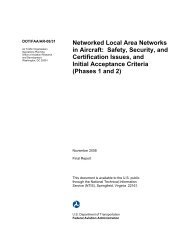Published Report (DOT/FAA/CT-94-36)
Published Report (DOT/FAA/CT-94-36)
Published Report (DOT/FAA/CT-94-36)
Create successful ePaper yourself
Turn your PDF publications into a flip-book with our unique Google optimized e-Paper software.
lunder resolution percentage exceeded the 98 percent criteria<br />
set by the TWG. Thus, the controller blunder resolution<br />
performance was satisfactory in the DIA simulation.<br />
5.2 NBO'S AND NTZ ENTRIES.<br />
An examination was conducted for NTZ entries that were not the<br />
result of a blunder or a breakout. Simulation data revealed that<br />
there were no NTZ entries by flight simulators or TGF aircraft.<br />
Therefore, the DIA runway spacings were sufficiently large that<br />
aircraft did not enter the NTZ as a consequence of TNSE.<br />
NBO's were typically the result of TNSE. NBO's occurred<br />
infrequently in the DIA simulation. Data indicated that 0.2<br />
percent of all non-blundering aircraft were broken out for<br />
reasons other than a conflict, loss of longitudinal separation,<br />
or loss of beacon signal (i.e., aircraft goes into coast).<br />
Overall, the low number of NBO's in the simulation indicated that<br />
controllers could accurately assess potential blunder situations.<br />
5.3 OPERATIONAL ASSESSMENT.<br />
The operational assessment of the DIA simulation was based on the<br />
opinions, conclusions, and recommendations of the participating<br />
controllers, technical observers, and the TWG.<br />
5.3.1 Controller Assessment.<br />
Controllers were asked to rate their stress level, activity<br />
level, and mental effort. Controllers rated their activity and<br />
stress levels as minimal to moderate. There was more stress and<br />
activity for controllers working the center runway. This was<br />
expected since the center runway was involved in all blunder and<br />
breakout situations.<br />
Controllers rated their mental workload as acceptable to moderate<br />
throughout the simulation. The amount of mental effort was not<br />
related to runway assignment. Situational factors associated<br />
with runway assignment (e.g. frequency of blunders, frequency of<br />
breakouts) required higher activity levels and produced more<br />
stress, but did not require any additional mental effort.<br />
Throughout the simulation, based on blunder resolution<br />
performance, the level of mental effort seemed appropriate for<br />
the task.<br />
The participating controllers agreed that they "safely monitored<br />
triple simultaneous ILS approaches at the simulated new Denver<br />
Airport using the FMA."<br />
44

















